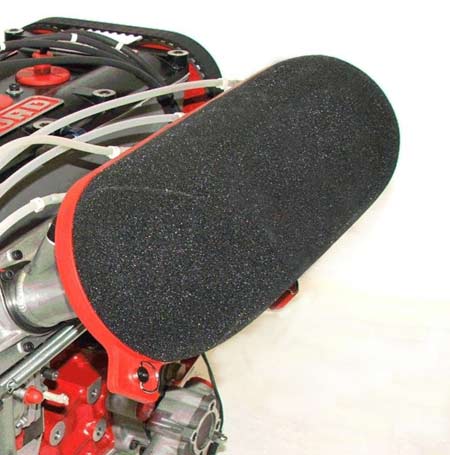The Air Filter
Viewers of Grand Prix in recent years can’t fail to have noticed the increasing amount of debris littering the sides of the track as the race proceeds. Clearly this is the inevitable result of the high rates of tyre degradation and wear during the race, designed to ’spice up’ the on-track action. However such debris can be a serious hazard to the internals of an internal combustion engine. And where perhaps I can think of many applications in the past when racers didn’t concern themselves with such things, these days an induction air filter on the engine of every serious racer is surely an absolute must.
Grand Prix racing is one thing, and one assumes that the organisers do their utmost to sweep the tracks clean afterwards. But for the rest of us with less exotic machinery, the real enemy is not necessarily tyre debris but other forms of unwanted matter - the dirt thrown up by the tyres themselves, dust and general organic matter from the world around us.
The technology of air filtration is outwardly very simple; the sieving or straining of the air to remove unwanted media. However, investigating the process in more detail, the mechanisms can actually be quite complex. And while paper or woven nylon/polyester filters may be common in automotive applications, in motorsport the most commonly found varieties are made from polyester foam.
The great issue with the more traditional type of paper technologies is that in trapping the dust or dirt, once trapped on its surface, the flow capacity of filter is reduced. For a given airflow, the pressure drop across the filter will be greater, resulting in a lower manifold pressure and lower ultimate power. Particles smaller than, say, 5 microns will pass through the filter and will either be find their way into the engine or end up in the lube oil. Particles larger than this will end up on the surface of the filter.
For foam filters, particularly those of the ‘wet’ or oiled type, the labyrinth of cells (which will be larger than that of the paper element) not only prevent the larger particles from passing through, but many of the smaller particles that will pass through this surface layer will be trapped within the body of the filter by the stickiness of the oil coating (on the foam). The structure of the foam and the mechanism that traps the dirt is therefore such as not to restrict the flow of air, ensuring minimal restriction of the flow of air for longer. For a given volume of dirt removed, this type of filter is therefore more efficient. Furthermore, by using several layers - perhaps as many as three - of progressively smaller pore size, dirt can be effectively ‘moved around’ within the filter to hold it more within the body of the foam.
Changing the number of pores per inch and the type of oil to wet it with can also change the characteristics of the unit, and so filters of this nature can be ‘tuned’ to be more effective depending on the environment.
But here’s the bit that most self-funded racers will love. Unlike paper-based systems, such filters can be washed and re-oiled on a regular basis, thus maintaining the maximum cleaning efficiency, so once purchased, the ongoing cost will be minimal.
Maximum filtering efficiency with the minimum of pressure drop into the intake manifold. Isn’t that all we need from a filter?

Fig. 1 - Foam air filter
Written by John Coxon